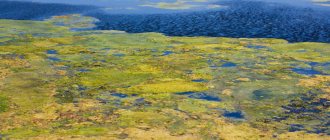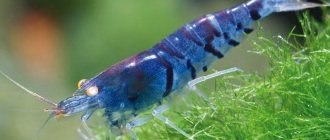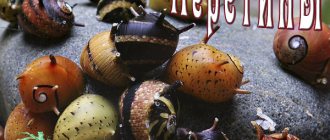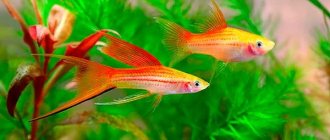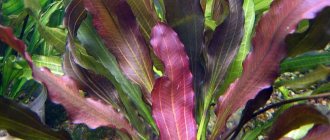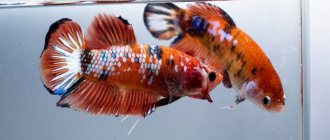Spirogyra is one of the representatives of the Zygnema family, belongs to the genus of filamentous green algae. This is the most common type of algae on the entire planet. She prefers reservoirs with fresh water (still or with a slight current). On the surface of lakes and ponds, as well as at the bottom, it can be seen in the form of a layer of mud covered with mucus. About 120 varieties of spirogyra are known in the CIS countries, and in total there are more than two hundred of them.
Read more: green filamentous algae in the aquarium.
Spirogyra is the most common type of algae
What is spirogyra
Spirogyra is a filamentous algae belonging to the Zygnema family. Along with chlorella, this is the most widespread vegetation in the world, which covers the surface of both fresh standing water bodies and salt and brackish waters.
Spirogyra is the most widespread plant in the world.
Spirogyra differs from its neighbor Chlorella in that it has a green pigment in its cells, while Chlorella has a brown pigment. Also, the difference is that Spirogyra is a multicellular protozoan algae, Chlorella is unicellular.
The discovery of the species occurred about 200 years ago.
In total, more than two hundred species of Spirogyra are known in the world, 120 of which are found in Russia and the CIS countries.
Causes of spirogyra
In natural conditions, scientists have identified several reasons for the appearance of green “cotton wool”. One of them is global warming and an increase in average ambient temperature. However, this alga feels great and reproduces in water areas with cold, sometimes icy, water.
Deterioration of the ecological situation is the main reason for the growth of Spirogyra
Also one of the reasons is the deterioration of the environmental situation on the planet. As described above, the source of plant nutrition is inorganic substances formed during the life process. Pollution of water bodies and the dumping of industrial waste into them, especially nitrogen-containing waste, significantly increases the rate of development of filament.
In addition, the environmental situation is also worsened by human household activities and the use of phosphate detergents. The annual increase in buildings on the banks of reservoirs, illegal landfills, sewage drains - all this inevitably leads to an imbalance in the ecosystem, contributes to the pollution of water bodies and the growth of huge masses of mud.
The same thing happens in home aquariums. The cause of algae may be:
- water in the tank is too warm;
- passion for mineral fertilizers in the process of growing aquarium flora;
- overfeeding fish;
- weak filtration system;
- dirty filter;
- dead fish;
- rare substitutions;
- bright intense light.
A weak filtration system is one of the reasons for the appearance of spirogyra in an aquarium.
Spirogyra in home aquariums
Spirogyra is one of the extremely aggressive weeds that clogs aquariums just like all other bodies of water.
Reasons for appearance
The appearance of spirogyra can be provoked by the processes of decay of organic residues in water, as well as by too active lighting and elevated water temperatures.
It is extremely difficult to fight spirogyra, so it is necessary to prevent water contamination so as not to have to deal with its removal later.
Characteristics of Spirogyra
Spirogyra belongs to the lower plants of the conjugate class, the body structure of which does not provide for the presence of tissues and organs, but consists only of identical cells located on top of each other.
Belongs to the department of green algae, which is determined by the presence in its cells of twisted chloroplasts - plastids, responsible for the process of photosynthesis, thanks to which green plants absorb oxygen and produce carbon dioxide, necessary for the growth and development of the entire plant world.
Where does Spirogyra live and biological features
Spirogyra is a border organism between the lower and higher plant worlds. Despite its primitive life activity and elementary structure, the algae is capable of growing and organizing entire colonies. Sometimes huge accumulations of cotton wool can completely cover the entire surface or bottom of natural reservoirs.
Most often lives in silted lakes, ponds, rivers, swamps
Most often this occurs in silted lakes, ponds, ditches, rivers, and swamps. The habitat of this algae is not limited to freshwater areas. It is found everywhere in lightly salted, salty seas and even mineral water sources. The habitat of the tenacious Spirogyra was discovered even high in the mountains at a distance of 5 km above sea level.
In the absence of proper care, plant threads appear not only in natural conditions, but also in pools and aquariums. Excess food, dead fish, elevated water temperature, poor filtration or an uncleaned, clogged filter, rare changes - all this contributes to the active appearance and growth of filament.
In the absence of proper care, the plant appears in the aquarium
Spirogyra is a lover of bright light, so intense lighting of a home pond will also promote the growth of green “cotton wool”.
Description and distinctive features
Spirogyra is one of the representatives of filamentous green algae. The name comes from the Greek words “spira” - spiral and “gyros” - curved. The structure of Spirogyra is very simple; its cell consists only of a shell, a nucleus, chromatophores and cytoplasm. Its life activity is also quite primitive, but such algae belong to a group of organisms that played a key role in the development of all life on earth. They were the first to invent efficient photosynthesis with the release of oxygen, which led to the creation of the atmosphere we are familiar with.
Accumulations of the thinnest filaments of Spirogyra form mud. These are cotton-like lumps covered with mucus. It has a rich green color and can cover the bottom of a reservoir or float in the thickness and on the surface of the water.
Where does Spirogyra live?
This is the most common type of algae throughout the earth. There are about 340 varieties of it in the world. Spirogyra lives in almost all bodies of fresh water that have a slight current or are still. Its habitat includes hot and mineral springs, ponds in Tibet at an altitude of over 5600 m and in Antarctica.
Human pollution of water due to the discharge of insufficiently treated industrial and sewage waste into water bodies has created favorable conditions for its rapid development in recent decades. In many reservoirs, there is a continuous overgrowing of the bottom or surface of the water with spirogyra, as well as its massive accumulations along the banks.
The growth of this algae poses two dangers:
- It changes the ecological system of the reservoir, displacing other plants; with them, the usual conditions for life and reproduction of the mass of animals are disrupted;
- The rotting of huge masses of spirogyra produces toxins, which directly poison all living things.
In Russia, scientists have long been sounding the alarm about the massive development of this algae in Baikal and the Volga. At the same time, it is capable of completely capturing smaller bodies of water, turning it into a stagnant swamp.
Spirogyra spores are carried by water, wind, insects and birds and contribute to its spread in ponds, swimming pools and home aquariums. Excess light, heat and organic matter accelerates its development.
Life cycle of Spirogyra
The life cycle of Spirogyra consists of several stages:
- vegetative reproduction or sexual conjugation;
- connection of cells of adjacent threads and formation of a copulation channel;
- flow and exchange of protoplasmic fluid between cells;
- a zygote is a plant cell in which an exchange of protoplasmic fluid has occurred;
- wintering of the zygote. During the cold period, the zygote is covered with a dense shell. With the onset of heat, meiotic division occurs underneath it, resulting in the formation of 4 spores. Three of them die, and the remaining cell grows by division into a new filament of spirogyra.
The development cycle of Spirogyra can be viewed more clearly in the diagram:
Spirogyra development cycle
Algae cells at all stages of the life cycle have a haploid set of chromosomes, with the exception of the zygote and zygospore stages.
Green algae
The most extensive department of algae, including from 13,000 to 20,000 species. They live mainly in fresh water bodies and are green in color due to the predominance of chlorophyll a and b in quantity over other pigments (carotenoids, xanthophylls). This department includes unicellular, multicellular and colonial forms. Most of them grow at a depth of 20-40 meters.
The cell wall of green algae is formed by cellulose, the reserve nutrient is starch. In many representatives in the life cycle there is an alternation of the sexual generation (gametophyte) and asexual generation (sporophyte).
Chlamydomonas
Chlamydomonas is a unicellular biflagellate green algae that lives in puddles, fresh water bodies, and ponds. The shape of the cell is pear-shaped. At the anterior end of the body it has two flagella, due to which it actively moves.
The light-sensitive eye (stigma) helps Chlamydomonas to occupy the most illuminated place for the active process of photosynthesis, which occurs in the chromatophore. Contractile (pulsating) cell vacuoles remove excess water that constantly enters, thus maintaining osmotic pressure at the level necessary for life.
Chlamydomonas has a cup-shaped chromatophore with a pyrenoid, a rounded protein granule containing an enzyme that is involved in the synthesis of sugars. Starch is stored around the pyrenoid.
Reproduction of Chlamydomonas
Reproduces primarily asexually. The sexual process is conjugation.
- Asexual reproduction
- Sexual reproduction
Under favorable conditions (summer) it reproduces asexually using zoospores. Chlamydomonas (n) divides mitotically twice without breaking the maternal membrane, resulting in the formation of 4 cells (n). They grow, each of them develops a flagellum, an eye and a cell wall appear. Over time, the maternal membrane surrounding the cells breaks and the zoospores are released into the external environment. Each zoospore develops into an adult cell.
Let's consider an isogamous sexual process, in which the gametes do not differ in structure, appearance, and are equally mobile.
Sexual reproduction is activated when unfavorable conditions occur (drying out of the reservoir, lowering the external temperature). Inside Chlamydomonas (n), germ cells are formed through mitosis - gametes (n). Remember that sexual reproduction always involves sex cells. 
Gametes (n) of different chlamydomonas fuse in pairs, resulting in the formation of a zygote (2n), which is covered with a dense protective membrane - a cyst. Under favorable conditions, the zygote (2n) divides by meiosis, resulting in the formation of 4 chlamydomonas (n).
Red snow
Red snow is a phenomenon characteristic of the polar regions of the Earth; it is also found on high mountains. The snow takes on an uncharacteristic red color associated with the massive proliferation of Chlamydomonas snowy, whose cells contain a red carotenoid - astaxanthin. Low temperatures are favorable for individuals of this species; at temperatures above +4 °C they die.
Chlorella
Chlorella is a single-celled green alga without flagella that lives in a variety of environments: on damp soil, on tree trunks, rocks, in salt and fresh water. Its accumulations are clearly visible in the form of a green coating.
The cell contains a cup-shaped chromatophore (looks like a heavily cut cup) that stores starch. Chlorella has a fast rate of cell division, which is why it is used for feed. Her photosynthesis is also very intense. This algae was one of the first to go into space; it is used on spaceships to produce oxygen.
Reproduction is carried out only asexually, the contents of the mother cell are divided mitotically into 4 or 8 daughter cells, after which the mother cell membrane breaks and the daughter cells come out, develop into adults, and then divide again.
Spirogyra
Spirogyra is a multicellular filamentous green algae. Accumulations of Spirogyra filaments on the surface of rivers and ponds form mud.
The chromatophore in Spirogyra is spiral-shaped, presented in the form of one or several ribbons encircling the cell in the wall layer of the cytoplasm. The cell contains a large nucleus located in the center and suspended on strands of cytoplasm.
Reproduces asexually and sexually.
- Asexual
- Sexual
Asexual (vegetative) reproduction can be carried out by parts of the thallus: the algae thread is torn into separate sections, or even cells that give rise to a new organism.
The sexual process is conjugation. Two threads of algae are located in parallel, the cells come closer together, and lateral outgrowths form on them. When the lateral outgrowths come into contact between cells of different algae filaments, a copulation channel is formed, through which the contents of one cell (n) move to another (n), after which the cytoplasm and nuclei merge, forming a zygospore (2n).
After a period of rest, the zygospore (2n) divides by meiosis, four cells (n) are formed, of which only one grows into a new individual, and the other three die.
Cladophora
Cladophora is a multicellular filamentous green algae. Its branching threads are loosely attached to the substrate, from which they are often torn off. The chromatophore has the appearance of a mesh (network). Asexual reproduction is carried out using zoospores, sexual reproduction in the form of isogamy.
Ulotrix
Ulotrix is a multicellular filamentous green algae. It lives in fresh and sea water and forms a green coating – mud – on underwater objects. The chromatophore is in the form of an open ring (belt) and contains a pyrenoid. It reproduces predominantly asexually, using four-flagellated zoospores. There is the possibility of sexual reproduction according to the type of isogamy.
The development cycle of ulotrix is dominated by the gametophyte (n) - the vegetative haploid generation. Also note that ulothrix (n) gametes are formed from thallus (n) cells by mitosis.
Pleurococcus
Most likely, any heterotroph will make a mistake the first time they encounter this name. It looks too much like the name of bacteria, such as staphylococci, streptococci. Remember and make no mistake: pleurococcus is a green algae. Pleurococcus has spherical cells; they can be single or connected in groups. There are no visible vacuoles in the cell; the chromatophore is in the form of a plate and does not contain pyrenoids.
It looks too much like the name of bacteria, such as staphylococci, streptococci. Remember and make no mistake: pleurococcus is a green algae. Pleurococcus has spherical cells; they can be single or connected in groups. There are no visible vacuoles in the cell; the chromatophore is in the form of a plate and does not contain pyrenoids.
Pleurococcus is ubiquitous and can withstand complete drying out. Forms a green coating on tree trunks, rock surfaces and soil.
Volvox
"Volvox" means "rolling". It is a green, mobile colonial algae with a spherical shape. One Volvox colony can reach 3 mm, and the number of cells can range from 200 to 10 thousand.
The cells are located on the periphery, connected to each other by strands of cytoplasm - protoplasmic filaments, providing colony movement and nutrition. In the center of the colony there is a cavity occupied by mucus. Each of the cells on the periphery has two flagella facing the external environment; the cells resemble Chlamydomonas.
Volvox plays a very important evolutionary significance, and helps to conclude that the development of living organisms from unicellular forms to multicellular ones occurred through colonial forms.
Most of the cells in a Volvox colony are vegetative. Vegetative propagation of Volvox occurs with the help of daughter colonies inside the mother colony, by special cells - parthenogonidia. These cells divide by mitosis perpendicular to the surface of the ball. As a result, a plate is formed, which turns out and forms a daughter ball. The daughter balls grow, and the mother body (ball) ruptures.
The sexual process occurs in specialized places - antheridia, where sperm develop (n), and oogonia, where eggs mature (n). The sperm penetrates the oogonia and a zygote or oospore (2n) is formed. Under favorable conditions, the zygote divides by meiosis, Volvox cells (n) are formed, which then divide through many mitotic divisions.
Thus, the main form of existence of cells in a Volvox colony is haploid (n), only the zygote (2n) is diploid in the life cycle.
Blue-green algae
I hasten to warn you about a very common misconception! Blue-green algae are not algae at all, they are also called cyanobacteria. They are a division of large gram-negative bacteria that are capable of releasing oxygen during photosynthesis.
Evolutionarily, blue-green algae are very ancient microorganisms that arose in the Archean. They have an extremely important role: they are the first photosynthetic organisms. Thanks to them, oxygen first appeared in the Earth's atmosphere 2 billion years ago.
They lack flagella and may have a filamentous or colonial shape, or be unicellular. The relatively large size of cyanobacteria and the similarity in structure with algae was the initial reason for their consideration as part of plants. Currently, the similarity of cyanobacteria with other bacteria has been proven.
© Bellevich Yuri Sergeevich 2018-2021
This article was written by Yuri Sergeevich Bellevich and is his intellectual property. Copying, distribution (including by copying to other sites and resources on the Internet) or any other use of information and objects without the prior consent of the copyright holder is punishable by law. To obtain article materials and permission to use them, please contact Yuri Bellevich
.
Plant nutrition
Since spirogyra does not have a root system that allows it to absorb nutrients from the soil, the plant is nourished only by sunlight. Filamentous cells contain a spiral-twisted chromatophore with chloroplasts (green plastids), which carry out photosynthesis.
Photosynthesis is the process of processing inorganic substances (for example, water and carbon dioxide) using light energy absorbed by chlorophyll (the green pigment of plants) and converting them into organic substances (for example, oxygen).
Spirogyra cells in the middle of the chloroplast have pyrenoids - small round formations in which starch is deposited during photosynthesis, turning into a kind of carbohydrate bricks. This type of nutrition is called autotrophic.
The plant uses the resulting carbohydrates for its nutrition and vital activity, providing the environment with the released oxygen, which is so necessary for all life on Earth.
The plant is nourished only by sunlight
Thus, the sources of nutrition for filamentous algae are everything that is in its habitat: carbon dioxide, water, energy from sunlight.
Reproduction options
Reproduction of Spirogyra, like most algae, is possible by asexual (vegetative) and sexual (conjugative) methods, despite the absence of germ cells.
Vegetative
Vegetative propagation involves increasing the plant population by breaking or accidentally damaging algal filaments. Falling into pieces, each segment turns into a new independent plant. Since Spirogyra threads become very tangled in the water column, their constant damage and ruptures are inevitable. Therefore, asexual reproduction occurs very intensively.
Sexual
Thanks to the tangling of algae threads, the process of sexual reproduction occurs through conjugation. This process is favored by warm weather and an ambient temperature of 18-30 degrees.
Intertwined with each other, the threads form a thick bundle and are closely pressed against each other. In this case, heterosexual cells of neighboring thalli come into contact and exchange cytoplasmic material through the formed intercellular channel. After copulation, the resulting zygote is covered with a dense shell and is separated from the main plant, turning into a zygospore.
Having survived the cold season, the zygospore nucleus is divided into 4 separate spores (meiosis). Three of them subsequently degenerate, and the strongest, germinating, gives rise to a new life.
Reproduction of Spirogyra by asexual and sexual methods
This exchange of genetic fluid allows the algae to improve its properties and become more resistant to unfavorable environmental conditions.
Role in nature
In nature, spirogyra is an integral element of the ecosystem and one of the most important sources of oxygen in a body of water. It forms dense thickets, important for the spawning of some fish. The dense weave of its threads reliably protects eggs and fry from predators. In addition, it serves as food for many species of fish and other inhabitants of water bodies.
But in large quantities it can lead to environmental disaster.
Why it is dangerous and useful
Having studied the characteristics of the life and reproduction of Spirogyra, we can conclude that all types of Spirogyra very quickly adapt to changing environmental conditions, and the dual method of reproduction allows it to grow at a catastrophic rate even in home aquariums.
Often the fight against threadworms becomes a whole problem for their owners. Quickly germinating and intertwining, the algae occupies a leading position and does not allow the growth of other plants that are necessary for aquarium inhabitants as food and housing. And the fry can even become entangled in the thick “hair” and die.
Although for some species of fish, filament serves as good food, as well as an excellent place for spawning and a reliable “storage” for fertilized eggs, protecting future offspring from the effects of adverse factors.
The main benefit of spirogyra is for scientists in laboratory research.
Undoubtedly, spirogyra brings the main benefit to scientists in terms of laboratory research and experiments. The large size of plant cells (0.01 mm) allows you to deeply study their anatomy, observe their structure, changes under the influence of various biological and chemical factors, and conduct scientific experiments.
Active growth of Spirogyra leads to water blooms
On the one hand, algae rich in chlorophyll, processing inorganic matter, release a large amount of oxygen necessary for the respiration of living organisms. On the other hand, this process inevitably leads to water blooming, rotting and waterlogging.
Excessive growth of “cotton wool” in irrigation canals, fish ponds and other reservoirs with economic purposes causes irreparable damage to human life.
Scientists and ecologists are especially alarmed because of the catastrophic spread of the described plant in Lake Baikal, unique in the whole world. It should be noted that among the species diversity of filamentous algae in this reservoir, it is Spirogyra link that causes the greatest concern:
- Firstly, the filament has grown in huge colonies not only on the surface, but also at a depth of 40 m, displacing the living creatures and vegetation endemic to Lake Baikal. For example, due to the growth of “cotton wool”, the population of gastropod snails, as well as Baikal sponges, which are responsible for the crystal clear water area of the lake, has significantly decreased. As a reason for the decline in omul numbers, ecologists also cite the proliferation of filamentous fish, which with their colonies have taken over the spawning grounds of yellowflies, the main source of food for the rare fish.
- Secondly, spirogyra, which are subject to putrefactive processes, cover the coast with a thick layer. Thus, the water in the lake in some places became unsuitable for use by people and animals. Fishing also becomes impossible due to the difficulties of moving on boats and filling fishing gear with algae mass.
Environmentalists are sounding the alarm due to the catastrophic spread of Spirogyra on Lake Baikal
Global measures are being taken at Baikal to cleanse and preserve the lake’s ecosystem, but the scale of the growth of “cotton wool” is enormous.
Ways to control the plant
There are several ways to combat the intensive growth of filament, depending on the type of reservoir. However, the rule “do no harm” should be observed, because defeating Spirogyra can provoke the death of the flora and fauna of the entire reservoir.
If spirogyra “attacks” the aquarium, first of all you need to take care of its hygiene: regularly change the water, clean the filter, and wash the soil. Lighting also plays an important role. It is recommended to reduce the operating time of lighting fixtures and plant tall aquarium plants in the container so that they create shade.
You can even darken the vessel for a couple of days to stop the active growth and nutrition of the “threads”.
Barbs that eat algae are added to the aquarium
As biological fighters, owners add algae-eating fish, such as barbs, platies, and guppies, into the aquarium. Shrimp also provide good assistance in this regard, for which filamentum serves as the main diet.
Unfortunately, the use of chemical methods against this plant is impractical because:
- chemistry does not act effectively on spirogyra;
- chemistry can cause the death of all living things in the aquarium.
Therefore, the “cotton wool” is removed manually, by wrapping it around a stick or brush.
As for the fight against mud in open water bodies, an integrated approach is needed:
- reducing the volume of wastewater, industrial emissions into water bodies, protecting the latter from agricultural waste with excess nitrogen-containing fertilizers;
- reducing the use or completely eliminating phosphates from detergents, which have a detrimental effect on the biocenosis;
- development and construction of modern treatment facilities at enterprises and waste disposal sites;
- development of eco-tourism and volunteer movement for large-scale manual cleaning of thread, calling on the population to make a personal contribution to environmental protection;
- introduction of fish that feed on mud, such as grass carp, into reservoirs;
- planting tall trees and shrubs along the banks to create shade and reduce exposure to the sun.
Grass carp feeding on algae is released into a pond
The use of special chemistry is impossible due to its destructive effect on the entire biosystem.
Of all the options for dealing with green mass, it is necessary to select the method that is least safe for the environment.
Today, the growth of filamentous thread causes serious damage to the ecological system of many reservoirs. It also causes a lot of trouble for aquarium owners. However, the appearance of green wool is not the cause of a disturbed ecology, but a consequence of its manifestation. Therefore, it is necessary to fight not with the algae itself, but with the factors that give rise to its active spread. After all, Spirogira itself, in moderate quantities, is of no small importance in the fish food chain and in enriching water bodies with oxygen.
Application
In folk medicine, fresh or dried and soaked spirogyra is applied to bruises, which helps to resolve the seals and reduce pain. When applied to wounds, it speeds up their healing. And its alcohol tincture is used for compresses in the treatment of ulcers and rashes due to diathesis.
The biomass of these algae, obtained by clearing Baikal of them, led to a number of experiments on their use in agriculture. In particular, the effectiveness of their use as an organic fertilizer and a basis for mulching the soil in order to maintain its moisture has been proven.
A technology has also been developed for its processing into briquetted fuel, including combined with waste processing products.
A number of studies have been carried out on the possibility of using spirogyra in wastewater treatment plants as one of the stages of water purification. It is able to effectively absorb nitrogen-phosphorus compounds from detergents and cleaning products, which is difficult to achieve with other means.
In Transbaikalia they are even trying to make designer wrapping paper and souvenirs with local flavor from it.
